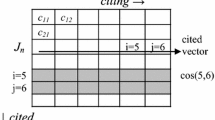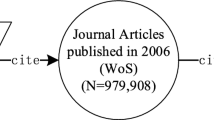Abstract
In bibliometrics, interdisciplinarity is often measured in terms of the “diversity” of research areas in the references that an article cites. The standard indicators used are borrowed mostly from other research areas, notably from ecology (biodiversity measures) and economics (concentration measures). This paper argues that while the measures used in biodiversity research have evolved over time, the interdisciplinarity indicators used in bibliometrics can be mapped to a subset of biodiversity measures from the first and second generations. We discuss the third generation of biodiversity measures and especially the Leinster–Cobbold diversity indices (LCDiv) (Leinster and Cobbold in Ecology 93(3):477–489, 2012). We present a case study based on a previously published dataset of interdisciplinarity study in the field of bio-nano science (Rafols and Meyer in Scientometrics 82(2):263–287, 2010). We replicate the findings of this study to show that the various interdisciplinarity measures are in fact special cases of the LCDiv. The paper discusses some interesting properties of the LCDiv which make them more appealing in the study of disciplinary diversity than the standard interdisciplinary diversity indicators.

Similar content being viewed by others
References
Aboelela, S. W., Larson, E., Bakken, S., Carrasquillo, O., Formicola, A., Glied, S. A., et al. (2007). Defining interdisciplinary research: conclusions from a critical review of the literature. Health Services Research, 42(1p1), 329–346.
Adelman, M. A. (1969). Comment on the “H” concentration measure as a numbers-equivalent. The Review of Economics and Statistics, 51, 99–101.
Allen, B., Kon, M., & Bar-Yam, Y. (2009). A new phylogenetic diversity measure generalizing the Shannon index and its application to phyllostomid bats. The American Naturalist, 174(2), 236–243.
Chao, A., Chiu, C. H., & Jost, L. (2010). Phylogenetic diversity measures based on Hill numbers. Philosophical Transactions of the Royal Society B: Biological Sciences, 365(1558), 3599–3609.
Chao, A., & Jost, L. (2012). Diversity measures. In A. Hastings & L. Gross (Eds.), Encyclopedia of theoretical ecology (pp. 203–207). Berkeley: University of California Press.
Chavarro, D., Tang, P., & Rafols, I. (2014). Interdisciplinarity and research on local issues: Evidence from a developing country. Research Evaluation, 23(3), 195–209.
European Commission. (2012). The grand challenge. The design and societal impact of Horizon 2020. European Commission, Directorate-General for Research and Innovation. EUR 25271.
Glänzel, W., & Schubert, A. (2003). A new classification scheme of science fields and subfields designed for scientometric evaluation purposes. Scientometrics, 56(3), 357–367.
Gotelli, N. J., & Chao, A. (2013). Measuring and estimating species richness, species diversity, and biotic similarity from sampling data. Encyclopedia of biodiversity, 5, 195–211.
Huutoniemi, K., Klein, J. T., Bruun, H., & Hukkinen, J. (2010). Analyzing interdisciplinarity: Typology and indicators. Research Policy, 39(1), 79–88.
Jensen, P., & Lutkouskaya, K. (2014). The many dimensions of laboratories’ interdisciplinarity. Scientometrics, 98(1), 619–631.
Jost, L. (2006). Entropy and diversity. Oikos, 113(2), 363–375.
Jost, L. (2007). Partitioning diversity into independent alpha and beta components. Ecology, 88(10), 2427–2439.
Jost, L. (2009). Mismeasuring biological diversity: Response to Hoffmann and Hoffmann (2008). Ecological Economics, 68(4), 925–928.
Klein, J. T. (1990). Interdisciplinarity: History, theory, and practice. Detroit: Wayne State University Press.
Laakso, M., & Taagepera, R. (1979). Effective number of parties: A measure with application to West Europe. Comparative Political Studies, 12(1), 3–27.
Larivière, V., & Gingras, Y. (2010). On the relationship between interdisciplinarity and scientific impact. Journal of the American Society for Information Science and Technology, 61(1), 126–131.
Leinster, T., & Cobbold, C. A. (2012). Measuring diversity: the importance of species similarity. Ecology, 93(3), 477–489.
Mugabushaka, A. M., Kyriakou, A., & Papazoglou, T. (2015). Bibliometric Indicators of interdisciplinarity exploring new class of diversity measures. In Y. Tonta, A. A. Akdag Salah, C. Sugimoto, U. Al (Eds.), Proceedings of ISSI 2015 Istanbul: 15th International Society of Scientometrics and Informetrics conference, Istanbul, Turkey, 29 June to 3 July, 2015, Bogaziçi University Printhouse, pp. 397–402.
National Academies (2005) Facilitating interdisciplinary research. Washington, DC: National Academies Press.
Pavoine, S., Ollier, S., & Pontier, D. (2005). Measuring diversity from dissimilarities with Rao’s quadratic entropy: Are any dissimilarities suitable? Theoretical Population Biology, 67(4), 231–239.
Porter, A. L., & Chubin, D. E. (1985). An indicator of cross-disciplinary research. Scientometrics, 8(3–4), 161–176.
Porter, A. L., Cohen, A. S., Roessner, J. D., & Perreault, M. (2007). Measuring researcher interdisciplinarity. Scientometrics, 72(1), 117–147.
Porter, A., & Rafols, I. (2009). Is science becoming more interdisciplinary? Measuring and mapping six research fields over time. Scientometrics, 81(3), 719–745.
Porter, A. L., Roessner, J. D., Cohen, A. S., & Perreault, M. (2006). Interdisciplinary research: Meaning, metrics and nurture. Research evaluation, 15(3), 187–195.
Porter, A. L., Roessner, D. J., & Heberger, A. E. (2008). How interdisciplinary is a given body of research? Research Evaluation, 17(4), 273–282.
Rafols, I., & Meyer, M. (2006). Diversity measures and network centralities as indicators of interdisciplinarity: Case studies in bionanoscience. SPRU working paper, 2006, November 30th.
Rafols, I., & Meyer, M. (2010). Diversity and network coherence as indicators of interdisciplinarity: Case studies in bionanoscience. Scientometrics, 82(2), 263–287.
Ricotta, C., & Szeidl, L. (2006). Towards a unifying approach to diversity measures: Bridging the gap between the Shannon entropy and Rao’s quadratic index. Theoretical Population Biology, 70(3), 237–243.
Roessner, D., Porter, A. L., Nersessian, N. J., & Carley, S. (2013). Validating indicators of interdisciplinarity: Linking bibliometric measures to studies of engineering research labs. Scientometrics, 94(2), 439–468.
Stirling, A. (2007). A general framework for analysing diversity in science, technology and society. Journal of the Royal Society, Interface, 4(15), 707–719.
Wagner, C. S., Roessner, J. D., Bobb, K., Klein, J. T., Boyack, K. W., Keyton, J., et al. (2011). Approaches to understanding and measuring interdisciplinary scientific research (IDR): A review of the literature. Journal of Informetrics, 5(1), 14–26.
Yegros, A., D‘Este, P., & Rafols, I. (2013). Does interdisciplinary research lead to higher citation impact. In The different effect of proximal and distal interdisciplinarity. Paper to be presented at the 35th DRUID Celebration Conference 2013, Barcelona, Spain, June 17–19.
Zhang, L., Rousseau, R., & Glänzel, W. (2015). Diversity of references as an indicator of the interdisciplinarity of journals: Taking similarity between subject fields into account. J Assn Inf Sci Tech,. doi:10.1002/asi.23487.
Acknowledgments
We thank Ismael Rafols for helpful comments on an earlier draft of the paper and Diego Chavarro for making the similarity matrix freely available.
Author information
Authors and Affiliations
Corresponding author
Additional information
Disclaimer The views expressed in this paper are the authors’. They do not necessarily reflect the views or official positions of the European Commission, the European Research Council Executive Agency or the ERC Scientific Council.
Rights and permissions
About this article
Cite this article
Mugabushaka, AM., Kyriakou, A. & Papazoglou, T. Bibliometric indicators of interdisciplinarity: the potential of the Leinster–Cobbold diversity indices to study disciplinary diversity. Scientometrics 107, 593–607 (2016). https://doi.org/10.1007/s11192-016-1865-x
Received:
Published:
Issue Date:
DOI: https://doi.org/10.1007/s11192-016-1865-x




